Scenic photographs: staging the Australian land
Jade Correge is undertaking a PhD within the School of Culture and Communication at the University of Melbourne. Her thesis looks into landscapes in Victorian children’s literature and most specifically fairy tales from the mid 19th century to the fin de siecle.
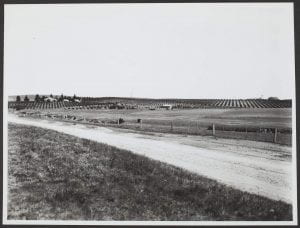
Thirty-five of the 1145 photographs in the Commercial Travellers’ Association’s collection have the word “scene” in their title. Statistically, such a number may seem small, however it is an intriguing detail if we consider other titles are mainly descriptive. Are these “[…] scenes” to be understood in terms of a location where some activity is taking place, or rather, should we consider the performative power imbued in the use of such a word?[1]

The concept of performativity occurs in various field such as speech act theory, gender studies, cultural studies and science and technological studies. In regard to photography, however, I wish to use it to refer to how subjectivity might performed in the photographs thereby creating another reality, or “scene”. Could the landscape perhaps be interpreted as the set of some dramatic action? I would argue that the framing term “scene” becomes a classification which demands the photograph does something, and that it endows the photograph with performativity by staging the landscape.
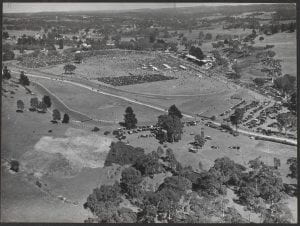
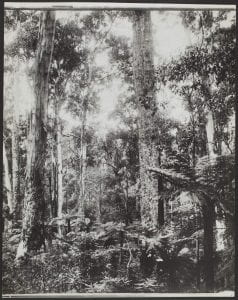
Two different categories stand out in this naming process. First, there are scenes showing the modernisation of the Australian countryside with photographs figuring the roads and the industrialisation of the land (Figures 1 and 2). These are followed by scenes of natural pageantry with photographs putting forth one element – a crowd, a collection of trees (a forest, the bush) or some water (rivers, a creek, a bay) (Figures 3, 4, and 5).
Taken in the 1920s-1950s, in the interwar period and after World War II, these “[…scene]” photographs also take part in the CTA’s mission to promote Australia by celebrating it as a modern country.[2] It is worth noting that 30 of the 35 “[…] scene” images were used to illustrate Australia Today, CTA’s annual magazine supplement, the purpose of which was to encourage British immigration.[3] Several photographs seem to to appeal to the English mind, such as we can see with two photographs poetically entitled “pastoral scene […]” which take their name from the presence of a flock of sheep at their centre (Figure 6, 7). Here, an idealization of the land takes place and the naming of this rural banality transcends the photograph by presenting the image of a peaceful shepherd’s life in a bucolic setting typical of English landscape paintings.
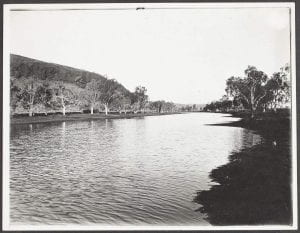

Another set of photographs worth looking at more closely are four photographs entitled “forestry scene” taken by the professional photographer Richard C. Strangman in the ACT. In this sequence which offers different perspectives on a single location, the forest shots transform from perspective focused on a hill or the ground (Figure 8, 9), to reveal a barren tree or green trees in the foreground towards a focus on the background hills that are depicted in a lighter shade (Figure 10, 11).
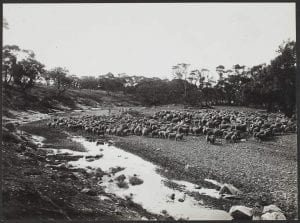
The high contrast in these photographs dramatizes the natural light and the shade of the trees; making them stand out in a rather theatrical way. Strangman may have wanted to debunk the myth of Australia as an austere inhospitable land by displaying its green trees and their protective nature. This serial arrangement of growing trees seems also intended to echo the potential of Australia as a growing nation. More than highlighting the charms of the Australian landscape, Strangman shows how it is a suitable land to live in. His photographs, akin to pictorial advertising, contribute to selling the dream of a great Australia by fostering the imagination of new immigrants. Their dramatic nature invites the white man to enter the scene. As a whole, in all of these “[…] scene” photographs, “scene” becomes a metonymy for a sense of nationalism.
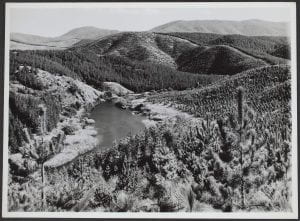
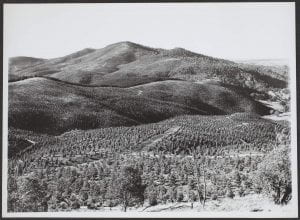
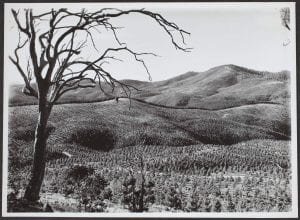

[1] An article observing how visual methods are affected by performativity can be located at this link: https://www.emerald.com/insight/content/doi/10.1108/17465641211223465/full/html
[2] For more information on the CTA see https://blogs.unimelb.edu.au/archives/the-many-stories-of-the-commercial-travellers-association/
[3] The remaining 5 were either aimed for the magazine but unused, or lack other metadata.
Leave a Reply